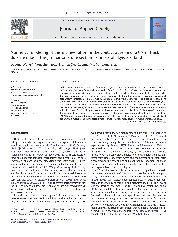摘要
In this study, we present a heat-transfer-model analysis of thermal evolution in the contact aureole of a 0.9 m thick dolerite dike in the Jurassic siltstone section from Isle of Skye, Scotland based on the constraints from the two types of vitrinite-reflectance geothermometers as well as geochemistry and burial history of host rocks. The predictions from the heat conduction models assuming the finite-time magma intrusion mechanism and pore-water volatilization can match well with both measured vitrinite reflectances and geological conditions of the host rocks. In the region where pore water volatilized and vitrinite reflectance rises with decreasing distance to the dike contact, the bomb geothermometer is consistent with the EASY%Ro model in validating the thermal evolution history of the host rocks, whereas it loses the function of temperature indicator out of the volatilization region. Possibly, the pore-water volatilization influenced the reliability of the bomb geothermometer. The computed total organic carbon contents based on the reconstructed thermal evolution history and the EASY%Ro model present the general agreement with the measured values, demonstrating the availability of the EASY%Ro model in indicating organic-matter transformation ratios at contact metamorphic conditions.
- 出版日期2013-2
- 单位大连理工大学
